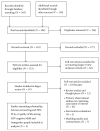Serosorting and HIV/STI Infection among HIV-Negative MSM and Transgender People: A Systematic Review and Meta-Analysis to Inform WHO Guidelines
- PMID: 26316960
- PMCID: PMC4437432
- DOI: 10.1155/2013/583627
Serosorting and HIV/STI Infection among HIV-Negative MSM and Transgender People: A Systematic Review and Meta-Analysis to Inform WHO Guidelines
Abstract
We conducted a systematic review and meta-analysis to assess the association between serosorting and HIV infection, sexually transmitted infections (STIs), and quality of life among men who have sex with men (MSM) and transgender people. Two reviewers independently screened abstracts and abstracted data. Meta-analyses were conducted using random effects models. Of 310 citations reviewed, 4 observational studies, all with MSM, met inclusion criteria. Compared to consistent condom use, serosorting was associated with increased risk of HIV (3 studies, odds ratio (OR): 1.80, 95% confidence interval (CI):1.21-2.70) and bacterial STIs (1 study, OR: 1.62, 95% CI: 1.44-1.83). Compared to no condom use, serosorting was associated with reduced risk of HIV (3 studies, OR: 0.46, 95% CI: 0.25-0.83) and bacterial STIs (1 study, OR: 0.81, 95% CI: 0.73-0.91). Among HIV-negative MSM, condom use appears to be more protective against HIV and STIs than serosorting and should be encouraged. However, serosorting may be better than no condom use as a harm reduction strategy.
Figures
Similar articles
-
Association between serosorting and bacterial sexually transmitted infection among HIV-negative men who have sex with men at an urban lesbian, gay, bisexual, and transgender health center.Sex Transm Dis. 2012 Dec;39(12):959-64. doi: 10.1097/OLQ.0b013e31826e870d. Sex Transm Dis. 2012. PMID: 23191950
-
Circumcision status and risk of HIV and sexually transmitted infections among men who have sex with men: a meta-analysis.JAMA. 2008 Oct 8;300(14):1674-84. doi: 10.1001/jama.300.14.1674. JAMA. 2008. PMID: 18840841 Review.
-
Effects of Pre-exposure Prophylaxis for the Prevention of Human Immunodeficiency Virus Infection on Sexual Risk Behavior in Men Who Have Sex With Men: A Systematic Review and Meta-analysis.Clin Infect Dis. 2018 Aug 16;67(5):676-686. doi: 10.1093/cid/ciy182. Clin Infect Dis. 2018. PMID: 29509889
-
Association between rectal douching and HIV and other sexually transmitted infections among men who have sex with men: a systematic review and meta-analysis.Sex Transm Infect. 2019 Sep;95(6):428-436. doi: 10.1136/sextrans-2019-053964. Epub 2019 May 9. Sex Transm Infect. 2019. PMID: 31073094
-
Sexually transmitted infections in Western Europe among HIV-positive men who have sex with men.Sex Transm Dis. 2007 Oct;34(10):783-90. doi: 10.1097/01.olq.0000260919.34598.5b. Sex Transm Dis. 2007. PMID: 17495592
Cited by
-
Research priorities in trans health: a Delphi-study.Front Public Health. 2024 Apr 12;12:1307531. doi: 10.3389/fpubh.2024.1307531. eCollection 2024. Front Public Health. 2024. PMID: 38680933 Free PMC article.
-
Stigma trajectories among people living with HIV (PLHIV) embarking on a life time journey with antiretroviral drugs in Jinja, Uganda.BMC Public Health. 2013 Sep 5;13:804. doi: 10.1186/1471-2458-13-804. BMC Public Health. 2013. PMID: 24010761 Free PMC article.
-
Gay and Bisexual Men's Perceptions of HIV Risk in Various Relationships.Am J Mens Health. 2018 Jul;12(4):655-665. doi: 10.1177/1557988317745759. Epub 2018 Jan 22. Am J Mens Health. 2018. PMID: 29355071 Free PMC article.
-
The Evidence Project risk of bias tool: assessing study rigor for both randomized and non-randomized intervention studies.Syst Rev. 2019 Jan 3;8(1):3. doi: 10.1186/s13643-018-0925-0. Syst Rev. 2019. PMID: 30606262 Free PMC article.
-
Positive choices: outcomes of a brief risk reduction intervention for newly HIV-diagnosed men who have sex with men.AIDS Behav. 2014 Sep;18(9):1808-19. doi: 10.1007/s10461-014-0782-3. AIDS Behav. 2014. PMID: 24771017 Free PMC article. Clinical Trial.
References
-
- Elford J. Changing patterns of sexual behaviour in the era of highly active antiretroviral therapy. Current Opinion in Infectious Diseases. 2006;19(1):26–32. - PubMed
Publication types
Grants and funding
LinkOut - more resources
Full Text Sources
Other Literature Sources
Miscellaneous




